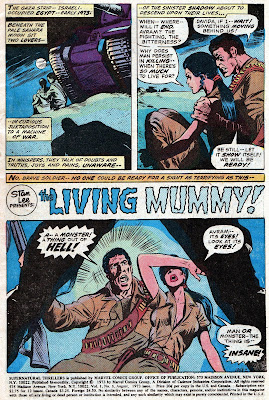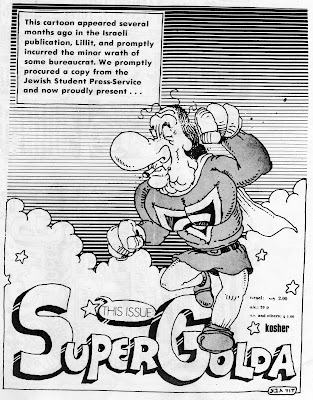In Jan. 1973, Yaakov Kirschen's comic strip Dry Bones debuted in The Jerusalem Post. It has become one of the oldest & well-known continuously-published English-language syndicated comic strips about Jewish & Israeli life. Although the artwork is simplistic and often consists of little more than a talking-head monologue or a dialogue between two talking heads, it is the sharp wit and timely obersvations that have gained it a worldwide following. Since 2005, Kirschen has published his new cartoons on his blog in full color, in addition to selected "classic" ones. His website allows him to comment on his cartoons and he welcomes comments from visitors to his site, as well.
Buy What a Country!: Dry Bones Looks at Israel
Buy Trees: The Green Testament (also by Yaakov Kirschen)
In Italy, a series of fumetti books by Roberto Raviola (aka Magnus), Lo Sconsciuto, told the story of a fictional mercenary. The following pages, which are self-explanatory, are from book 6 - Vacanze a Zahl.





One of the superheroes introduced in the '70s by Marvel was The Living Mummy. However, the character didn't become very popular and not many stories were published. In the first few pages of the first story, The Living Mummy (a seemingly Egyptian archetype) encounters a pair of Israeli soldiers. Although it would seem like a modern version of Egyptian-Israeli conflict, that isn't the case. The mummified hero turns out to be African, the leader of an enslaved tribe, giving him a historical connection to the Jews and, thus, Israelis. Though at first, the Mummy seems ready to retaliate against the soldiers (who felt threatened by his monstrous appearance), the Mummy changes his mind after seeing the female soldier close up (Supernatural Thrillers #5, Aug. 1973).

Buy Supernatural Thrillers #5
In another story ("A Choice of Lions", Supernatural Thrillers #10 Dec. 1974), the Living Mummy finds himself stepping into the middle of a one-sided battle between a female Israeli soldier and a tank. Recalling his own need to prove himself as a warrior long ago, the Mummy helps even the odds, allowing the lone Israeli soldier to blow up the tank and pass her "test".

Buy Supernatural Thrillers #10
In 1972, Israeli cartoonist Dudu Geva published a short English-language cartoon called "Super Golda" in the publication Lillit, which was reprinted via the Jewish Student Press-Service. Rather than duking it out with dangerous super-powered criminals, Super-Golda-Meir must battle ... intellectuals who criticize her government policy!


"Introducing Mind-Wave and His Think Tank!" (Daredevil #133, May 1976) guest-starred real-life Israeli celebrity (& alleged super-psychic) Uri Geller.

Buy Daredevil #133
"The Warning of the Wonder Twins" (Super Friends #7, Oct. 1977) introduced the Israeli superhero Seraph, a walking Biblical stereotype, seen here teamed up with Superman, whom he rescues from a gravity field.

Buy Super Friends #7
The following year, 15-year old Uri Fink wrote & illustrated the short-lived Israeli superhero series Sabraman.





No comments:
Post a Comment